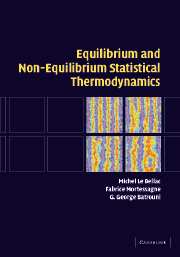Book contents
- Frontmatter
- Contents
- Preface
- 1 Thermostatics
- 2 Statistical entropy and Boltzmann distribution
- 3 Canonical and grand canonical ensembles: applications
- 4 Critical phenomena
- 5 Quantum statistics
- 6 Irreversible processes: macroscopic theory
- 7 Numerical simulations
- 8 Irreversible processes: kinetic theory
- 9 Topics in non-equilibrium statistical mechanics
- Appendix
- References
- Index
3 - Canonical and grand canonical ensembles: applications
Published online by Cambridge University Press: 03 December 2009
- Frontmatter
- Contents
- Preface
- 1 Thermostatics
- 2 Statistical entropy and Boltzmann distribution
- 3 Canonical and grand canonical ensembles: applications
- 4 Critical phenomena
- 5 Quantum statistics
- 6 Irreversible processes: macroscopic theory
- 7 Numerical simulations
- 8 Irreversible processes: kinetic theory
- 9 Topics in non-equilibrium statistical mechanics
- Appendix
- References
- Index
Summary
This chapter is devoted to some important applications of the canonical and grand canonical formalisms. We shall concentrate on situations where the effects of quantum statistics, to be studied in Chapter 5, may be considered as negligible. The use of the formalism is quite straightforward when one may neglect the interactions between the elementary constituents of the system. Two very important examples are the ideal gas (non-interacting molecules) and paramagnetism (non-interacting spins), which are the main subjects of Section 3.1. In the following section, we show that at high temperatures one may often use a semi-classical approximation, which leads to simplifications in the formalism. Important examples are the derivation of the Maxwell velocity distribution for an interacting classical gas and of the equipartition theorem. These results are used in Section 3.3 to discuss the behaviour of the specific heat of diatomic molecules. In Section 3.4 we address the case where interactions between particles cannot be neglected, for example in a liquid, and we introduce the concept of pair correlation function. We show how pressure and energy may be related to this function, and we describe briefly how it can be measured experimentally. Section 3.5 shows the fundamental rôle played by the chemical potential in the description of phase transitions and of chemical reactions. Finally Section 3.6 is devoted to a detailed exposition of the grand canonical formalism, including a discussion of fluctuations and of the equivalence with the canonical ensemble.
- Type
- Chapter
- Information
- Equilibrium and Non-Equilibrium Statistical Thermodynamics , pp. 95 - 174Publisher: Cambridge University PressPrint publication year: 2004



